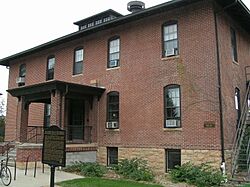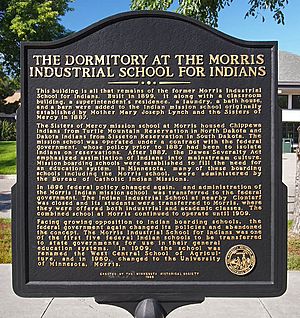Morris Industrial School for Indians facts for kids
Quick facts for kids Morris Industrial School for Indians |
|
|---|---|

Dormitory of the Morris Industrial School for Indians today on the campus of University of Minnesota Morris
|
|
| Location | |
|
,
|
|
| Coordinates | 45°35′23″N 95°54′10″W / 45.58972°N 95.90278°W |
| Information | |
| School type | Native American boarding school |
| Founded | 1887 |
| Status | Closed |
| Closed | 1909 |
| Grades | Kindergarten–Eighth |
| Enrollment | 100–160 |
| Nickname | Morris Indian School |
|
Morris Industrial School for Indians Dormitory
|
|
|
U.S. Historic district
Contributing property |
|
| Location | 600 East 4th Street, Morris, Minnesota |
| Area | Less than one acre |
| Built | 1899 |
| Part of | West Central School of Agriculture and Experiment Station Historic District (ID02001707) |
| NRHP reference No. | 84001696 |
| Significant dates | |
| Added to NRHP | May 10, 1984 |
| Designated CP | January 15, 2003 |
The Morris Industrial School for Indians was a special school for Native American children. It was located in Morris, Minnesota. The school operated from 1887 to 1909.
At first, Catholic nuns from the Sisters of Mercy ran the school. This was from 1887 to 1896. Later, the United States government took over. The government's Office of Indian Affairs managed the school from 1898 to 1909.
When the government took charge, they added new programs. These included music, a reading club, and a baseball team. In 1910, the school became an agricultural high school. It was part of the University of Minnesota system. Later, in 1960, it became a public college called the University of Minnesota Morris.
Only one building from the original school still stands today. It is an 1899 dormitory. This building is now listed on the National Register of Historic Places. It is used as the university's Multi-Ethnic Resource Center.
How the School Started
The Morris Industrial School for Indians began in 1887. It was started by nuns from the Sisters of Mercy group. Their leader was Mary Joseph Lynch. She had helped Florence Nightingale during the Crimean War. After that, she started schools for young people in the United States.
A local priest in Morris, Minnesota asked the nuns to open a school for girls. But the nuns wanted to teach Native Americans. In 1886, the U.S. government agreed to pay them to run such a school. They named their new school the Sacred Heart Indian Mission. The nuns built the first school buildings themselves.
It was hard for Lynch to find students from Native American reservations. These are lands set aside for Native American tribes. But she made friends with the Turtle Mountain Band of Chippewa Indians. Many people in this tribe were Catholic.
The school slowly grew. By 1895, there were 25 staff members and 103 students. It became the biggest Native American boarding school in Minnesota. Lynch kept the school focused on religious education. But she did not allow physical punishment, which was common in some other schools.
Government Takes Over
The U.S. government started changing its rules for schools. It began to stop paying church-run schools. This meant less money for the Morris school. The government ended its contract with the nuns on July 1, 1896. Mary Joseph Lynch was very sad about this.
The government decided to buy the school from the Sisters of Mercy. But they paid only half of what the nuns asked for. The government then opened the school again in 1898.
The new leader, William H. Johnson, made many changes. He added "progressive education" programs. This meant new ways of teaching. Students learned from kindergarten to eighth grade. The school added music, more sports, and a literary society for reading and writing.
New brick buildings replaced the old wooden ones. A new water and sewer system was built. The government also bought a lot of farmland. This was for teaching students about farming. Most students came from Ojibwe reservations, especially the Turtle Mountain Chippewa.
Johnson tried hard to keep students at the school. He made terms longer and would not let students go home for breaks. He even sent staff to bring students back if they left. Tribes and other teachers often complained about these methods. Johnson also accepted some white students who wanted free education, even if they were not Native American. He was fired in 1901. John B. Brown took over as the new leader.
Brown continued with similar progressive programs. He was not as strict as Johnson. About 160 students attended the school each year during Brown's time. In 1908, a new law was passed. It said there should be fewer federal Native American boarding schools. Instead, more schools should be built on reservations. Native Americans had asked for this so families could stay together.
The Morris Industrial School for Indians was chosen to be given to the state government. The state would use it to educate white students. In return, the state would offer free education to Native Americans. The school was given to the state on December 9, 1908. It officially closed in June 1909.
Baseball Team
When the government ran the school, sports became a big part of learning. Baseball was the most popular sport. In the late 1890s, the school team played against teams from the town of Morris.
Starting in 1901, the school team played many high school teams. Local newspapers started to notice them. The team did not have coaches. The players learned most of their skills from each other.
From 1905 to 1907, they became a strong regional team. They won many games against other high schools. In 1908, they beat some of the best teams in the area. They won a four-team tournament. They also defeated the Wahpeton High School team, which was called "champions" in North Dakota. That season, they won 11 games and lost only 1. Newspapers called them "champions of this part of the state."
Many players went on to play for traveling baseball teams or in minor leagues. The most famous player was Charles Robert Roy. He was from the White Earth Band of Ojibwe. After graduating in 1904, Charlie Roy pitched for another Native American school team. Then he signed a professional contract with the Philadelphia Phillies. Roy played eight games for the Phillies in 1906. He then played for several minor league teams.
What Happened Next
In 1910, the State of Minnesota changed the school into the West Central School of Agriculture. This was a high school for farming. It was part of the University of Minnesota. In 1960, the campus became the University of Minnesota Morris.
Two buildings from the Morris Industrial School for Indians still exist. A wooden house built in 1905 for the school leader was moved in 1937. It is now at 540 West 5th Street. The other building is the 1899 boys' dormitory. It is still in its original spot.
The Morris Industrial School for Indians Dormitory was added to the National Register of Historic Places in 1984. It is important because it shows how the government changed its policies toward Native Americans in the late 1800s. The government tried to encourage Native Americans to adopt American culture.
When the campus became the West Central School of Agriculture, the dormitory was used for students for a few years. Then it became the Music Hall for most of the school's 50 years. Today, it is the Multi-Ethnic Resource Center for the University of Minnesota Morris.


